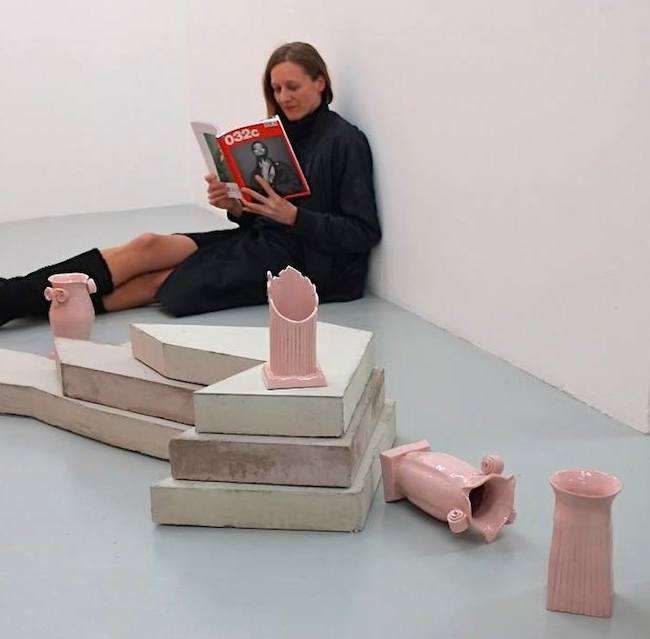BERLIN — On the heels of Liene Bosquê’s Dismissed Traces in New York is another exhibition that uses contemporary ceramic art to comment on architecture. Berlin artist Isa Melsheimer showed her Brutalist-inspired sculptures at the Esther Schipper gallery in Über die Dünnhäutigkeit von Schwellen (Berlin March 12 — April 16). Roughly translated “over the thin skin of sleepers,” the exhibition contains clay and concrete works that are Melsheimer’s reinterpretations of forgotten brutalist buildings. They’re partly objects of study, partly representations of the buildings’ other natures, something that exists but hasn’t been seen yet.
Above image: Isa Melsheimer at an earlier exhibition, “Times are Hard, but Postmodern,” at Galerie Jocelyn Wolff, Paris.

Exhibition view: Isa Melsheimer, ÜBER DIE DÜNNHÄUTIGKEIT VON SCHWELLEN, 2016 at Esther Schipper, Berlin.
The gallery states that the rooms in the exhibition also were altered by a network of threads that address the changeability and fragility of space, both in general and in the context of the work.
The artist acts as archeologist of often forgotten or neglected buildings, recreating their distinctive shapes both from her study and from her vivid re-imagining of the forms and the spirit of the structures. Even if the individual buildings are not all well known and therefore might not be immediately recognized, the formal language is familiar and has become a ubiquitous part of the urban landscape. Her work seeks to examine the connotations of the building’s historical and architectural context, and the ideological connotations with which its materials, aesthetics, and functions may be imbued.

Isa Melsheimer, Ceramic I (exhibition view), 2016, ceramic and glaze, 25 x 13 x 15 cm, 14.5 x 13 x 10 cm, 22 x 11 x 15 cm
The concrete works in this exhibition take as points of reference Brutalist buildings that were neither popular nor critical successes and have subsequently been demolished.
In her gouaches of architectural sites Isa Melsheimer constructs small autonomous worlds, seemingly detached from their real-world settings. The artist often choses black and white source material showing the building in their original condition, that is, without signs of subsequent decay or dilapidation and without later architectural or landscaping additions. Isa Melsheimer effectively reimagines the colors of the buildings and their interiors, unrestrained by the strictures of verisimilitude. The impression of these structures existing in a self-contained, timeless space is further emphasized by the fantastic elements that appear in these environments: wild animals like foxes or porcupines, clusters of brilliantly colored crystalline formations and/or extravagantly dark starry night skies.

Isa Melsheimer, Possibility of a Ruin VIII, 2016, reinforced concrete, ceramic and pedestal, 50 x 50 x 50 cm (concrete), 30 x 17 x 13 cm (ceramic), 100 x 50 x 50 cm (pedestal)

Ilsa Melsheimer, Hyberboloïde IX, 2016, thread and nails, 1440 x 361 x 391 cm. Photographs by Andrea Rosetti, courtesy of the gallery.
Isa Melsheimer’s glazed ceramics find another kind of representation of architectural structures that depart in scale, material and color from their sources. Although their scale recalls the miniaturized and schematic appearance of preliminary architectural models, the material and colors add a fantastic, playful aspect, and even let the works appear akin to individual personages.
Isa Melsheimer (b. 1968, Neuss) studied at the Berlin University of the Arts. Selected solo exhibitions include: Kontrastbedürfnis, Ernst Barlach Haus, Hamburg (2015), Marianne- Werefkin-Prize, Haus am Kleistpark, Berlin (2015); Synapsen, ikop Museum für zeitgenössische Kunst, Eupen (2014). Selected group exhibitions include: Jahresmuseum 2015: der schwierige raum, Kunsthaus Mürz, Mürzzuschlag (2015); Le fil rouge, Espace Louis Vuitton, Paris (2015), (Un)möglich! Künstler als Architekten, Marta, Herford (2015); Backdoor Fantasies/Fluchtwege und Hintertüren, KAI 21/Arthena Foundation, Dusseldorf (2014); Jäger & Sammler in der zeitgenössischen Kunst, Museum Morsbroich, Leverkusen (2014); The Night of Villa Massimo at Martin-Gropius-Bau, Martin-Gropius-Bau, Berlin (2014). She lives and works in Berlin.
Text (edited) and photographs courtesy of the gallery.
Do you love or loathe these works of contemporary ceramic art? Lets us know in the comments.



Add your valued opinion to this post.